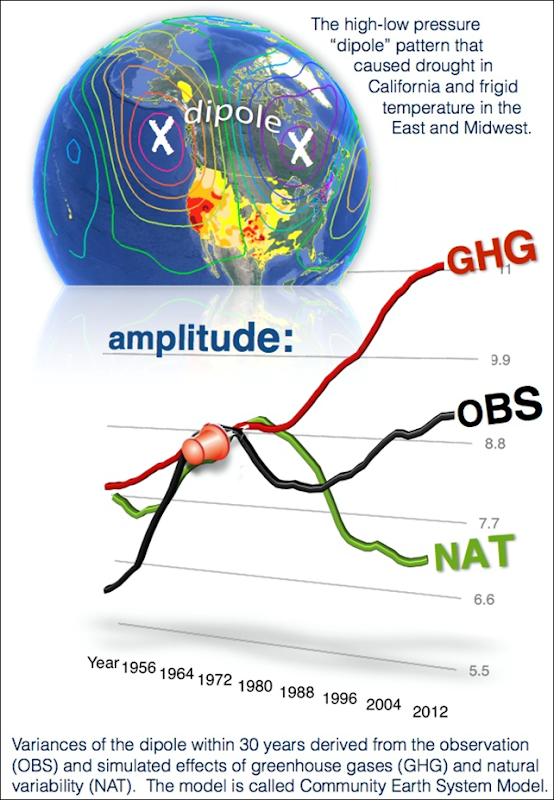Study ties epic California drought, ‘Frigid East’ to anthropogenic climate change
By Joe Romm
15 April 2014 (Climate Progress) – Natural variability alone cannot explain the extreme weather pattern that has driven both the record-setting California drought and the cooler weather seen in the Midwest and East this winter, a major new study finds. We’ve reported before that climate scientists had predicted a decade ago that warming-driven Arctic ice loss would lead to worsening drought in California. In particular, they predicted it would lead to a “blocking pattern” that would shift the jet stream (and the rain it could bring) away from the state — in this case a “Ridiculously Resilient Ridge” of high pressure. A new study in Geophysical Research Letters (subs. req’d) takes the warming link to the California drought to the next level of understanding. It concludes, “there is a traceable anthropogenic warming footprint in the enormous intensity of the anomalous ridge during winter 2013-14, the associated drought and its intensity.” The NASA-funded study is behind a pay wall, but the brief news release, offers a simple explanation of what is going on. The research provides “evidence connecting the amplified wind patterns, consisting of a strong high pressure in the West and a deep low pressure in the East [labeled a ‘dipole’], to global warming.” Researchers have “uncovered evidence that can trace the amplification of the dipole to human influences.” [more]
Bombshell: Study Ties Epic California Drought, ‘Frigid East’ To Manmade Climate Change 
(NASA) – The news fever on the California drought and the frigid East may be fading, but the scientific debate on the role of climate change is just beginning. New research by Utah State University climate scientists has shown evidence connecting the amplified wind patterns, consisting of a strong high pressure in the West and a deep low pressure in the East, to global warming. Referring to such high-low pressure patterns as a “dipole”, USU researchers, who are working for a NASA funded project, have uncovered evidence that can trace the amplification of the dipole to human influences. Specifically, they found that the dipole tends to form one year before El Niño – widespread tropical Pacific warming that cause worldwide climate anomalies. This research explains why the 2013-2014 drought in California occurred during neither a El Niño nor a La Niña year. California is facing increasing pressure to resolve tensions involved in apportioning its water among municipal, agricultural, industrial users. Thus, it is important to note that the dipole is projected to intensify, which means more extreme future droughts for California. Historical data show that the dipole has been intensifying since the late 1970s. The intensified dipole can be accurately simulated using a new global climate model, which also simulates the level of greenhouse gases in the atmosphere. Simulations with only natural variability show a weakening dipole, which is opposite to what is currently being observed. Moreover, the occurrence of the dipole one year before an El Niño/La Niña event is becoming more common, which can only be reproduced in model simulations when greenhouse gases are introduced into the system. According to the study, the persistent dipole and subsequent drought in California is part of a natural variability related to the initiation of El Niño, rather than El Niño itself. But this relationship has strengthened in response to increased greenhouse gases in the atmosphere. Looking into the future, the dipole and its indication of impending El Niño may suggest wet conditions in California later this year, when El Niño is predicted to happen.
Science Links California Drought to Human-caused Climate Change [pdf]
